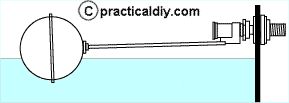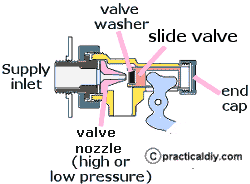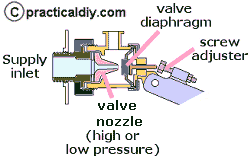Ball valves
 One of the methods used to control the flow of water into water cisterns and tanks is the use of ball (aka float) valves.
One of the methods used to control the flow of water into water cisterns and tanks is the use of ball (aka float) valves.
Put simply, a float on the water inside a cistern or tank is attached to an arm which operates a valve which controls the inflow of water
As the water level in the tank drops, the arm falls and opens the valve to allow water to enter the tank.
Then. as the water flows in, the water level rises, as does the ball thus moving the arm which then closes the valve shutting off the water flow.
The floats
Although these types of valves are often referred to a 'ball valves', the 'ball' actually refers to the typical shape of the float, however the float can be any shape - narrow cisterns with limited space inside will often use narrow, non-spherical floats.
Typically the floats are just screwed onto the end of the arm, sometimes with a locknut on the arm itself. Floats can sometimes leak over time (not very common with plastic floats, more common with the older style metal floats), replacement just involves removing the old float and attaching a new one to the end of the arm - always fit the same style and size of float as originally fitted.
Controlling the water level
The level of water in the tank is determined by the arm between the float and the valve and the arm can be adjusted to change the level - moving the float downwards in relation to the valve will lower level of water in the tank, or raising the float will raise the water level. There are three commonly used methods for adjusting the arm, and thus the level of water in the tank:
- The most common method is by just physically bending the solid brass arm between the float and the valve. This is done by firmly gripping the arm in both hands, holding the arm near to the valve still (so that no pressure is put on to the valve itself) and using the other hand nearer the float to bend the arm by a small amount, either up or downwards to achieve the required water level.
- Other systems incorporate a hinge in the middle of the arm with a screw and lock nut - adjustment is by loosen the lock nut and adjusting the hinge to raise or lower the float.
- The other arrangement incorporates an adjustment screw (often with a lock nut) on the arm near to the valve, releasing the lock nut allows the screw to be adjusted which changes the point at which the valve shuts off.
The valves
The slide (or piston) valve and the diaphragm valve are two valves commonly used to control the flow of water into the tank.
Both types incorporate a valve nozzle to reduce the flow into the valve, there are two style of nozzle; referred to as high and low pressure (valves are usually supplied with both types, one fitted and the other supplied separately). Which style of nozzle needs to be fitted depends upon whether the water feed is from the water mains (in which case, the high pressure valve nozzle - with the smaller feed hole - is used) or from a gravity fed tank (in which case, the low pressure valve nozzle - with the larger feed hole - is used). Should the wrong type of nozzle be fitted, problems will arise:
- A low pressure nozzle fitted in a mains water fed, the valve will not close property thus causing water to flow in to the tank/cistern when it should be shut off.
- Using a high pressure nozzle in a gravity fed system will cause the tank to fill up very slowly and probably shut the water off below the required level.
The correct valve nozzle for the feed system must be fitted to the valve at installation, this involves dismantling the valve by releasing the large nut holding the body of the valve to the inlet and replacing the nozzle.
The slide valve
 A cross-section of a typical slide valve is shown to the right.
A cross-section of a typical slide valve is shown to the right.
As changes in the water level in the tank moves the float arm moves up and down, the cam at the end of the arm inside the body of the valve moves the slide valve towards or away from the feed hole in the valve nozzle. When the washer on the end of the slide valve seals the valve nozzle, the water supply is shut off.
Then, as the water in the tank falls, the slide valve is moved away from the valve nozzle and water is allowed to flow in to the tank so filling it up.
In the past, a 'silent feed' pipe (a short pipe from the valve down into the water in the tank) was often fitted to the valve. As the water was fed directly into the tank below the water level, there was a reduction in the noise of water filling the tank. However, 'silent feed' pipes are now banned as there is a danger that water could be drawn back in to the water feed if there is a failure of mains water pressure - if one of these pipes is found to be fitted, it should be removed and thrown away.
Slide valves are very robust and generally reliable - the only point of wear normally being the washer on the end of the slide. Modern slide valves are usually made from plastic and do not suffer from deposit build up or corrosion as much as the ones made from brass.
Slide valves do not normally suffer from wear, the valve washer may need replacement, especially if the supply water is dirty.
The diaphragm valve
 A cross-section of a typical diaphragm valve is shown to the right.
A cross-section of a typical diaphragm valve is shown to the right.
Like the slide valve above, the diaphragm valve is controlled by an arm attached to a float. As the arm rises with the water level, the screw adjuster on the top of the arm pushes a 'plunger' in the end of the valve, this in turn closes the valve nozzle by moving the diaphragm against it.
One advantage of the diaphragm valve over the slide valve is that there is less build-up of deposits in hard water areas as the only moving part in contact with the water is the diaphragm itself.
As mentioned above for slide valves, the outlet from diaphragm valves were, in the past, often fitted with a 'silent feed' pipe which fed the water from the valve to below the water level in the tank; 'silent feed' pipes are now banned as there is a danger that water could be drawn back in to the water feed if there is a failure of mains water pressure - if one of these pipes is found to be fitted, it should be removed and thrown away.
